Understanding user intent is crucial to creating a successful marketing strategy. And the first step in doing that is understanding the marketing funnel.
In this blog, we will delve deeper into what a marketing funnel is and how it has evolved. We will discuss the different stages of the funnel- ToFu, MoFu, and BoFu– and how you can utilize them for your business.
We will also explore upper-funnel marketing vs lower-funnel marketing, their importance, and strategies to implement them successfully.
Additionally, we will compare top-of-funnel vs. bottom-of-funnel approaches and how they differ for B2C and B2B brands.
Finally, we will provide examples of companies that have implemented successful marketing funnels to help you better understand how you can use them to grow your business.
What is a Marketing Funnel?
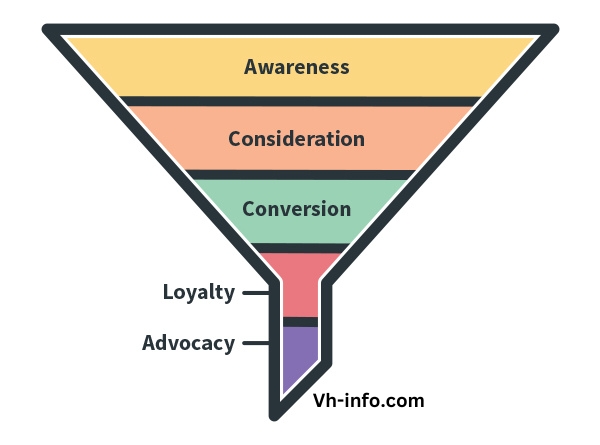
The marketing funnel guides potential customers into making a purchase. It has stages like awareness and decision-making where leads ultimately become customers. However, not all leads turn into customers. Every business’s funnel is unique with different terms and actions. The goal is to gradually lead prospects through each stage, narrowing down the candidates for purchasing.
Think of the marketing funnel as a journey from getting people interested in a product or service to turning them into happy customers. Picture it as a funnel because, at the beginning, you try to attract a lot of people, just like pouring water into a wide funnel. As these people learn more and move through the process, some will drop off, and that’s okay. The goal is to guide them smoothly through stages like awareness, interest, decision, and action, where they finally become customers.
Ideally, we’d want a perfect cylinder, turning all leads into customers, but in reality, it’s about making the funnel as cylindrical as possible by converting as many leads into customers as we can. Remember, the specifics of the funnel may vary depending on the type of business, but the main idea is to guide people from curiosity to making a purchase and understanding a customer’s journey.
The History of the Marketing Funnel
In the early 1900s, a savvy advertising pro named Elias St. Elmo Lewis came up with the AIDA model, outlining the steps in a customer’s journey: Awareness, Interest, Desire or Decision, and finally, Action.
This model highlighted how people become aware of a problem, show interest in solutions, decide on a brand, and then take action to become customers. Fast forward to 1924, William H. Townsend merged this AIDA model with the concept of a funnel.
Now, imagine the ‘awareness‘ stage as a big pool of potential customers seeking solutions. Some get to the ‘interest‘ stage, while others explore other options.
Those in ‘interest‘ start comparing products, slipping into the ‘desire‘ or ‘decision‘ stage, and finally, some take action and become customers.
A smart marketing strategy pulls in lots of promising prospects, guiding them through each stage until they become happy customers.
The Evolution of the Marketing Funnel

The marketing funnel has changed a lot since it was first created in 1924. Nowadays, there are many different versions of it that people use.
ToFu, MoFu and BoFu
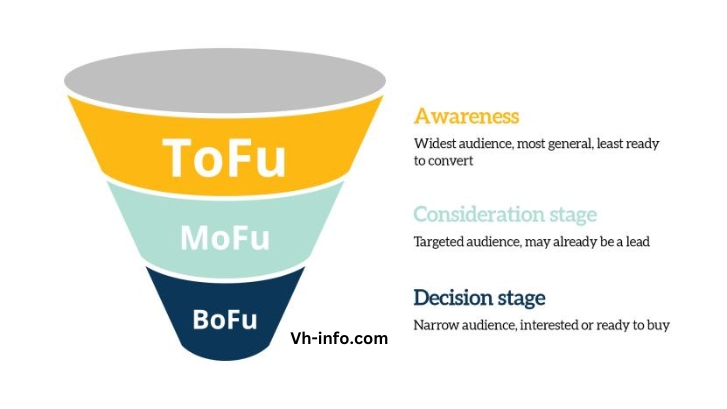
Marketers love their acronyms, and here are a few:
“TOFU” means the Awareness Stage, where people are getting to know your brand and the issues you can help with.
Then comes “MOFU,” which stands for the Consideration Stage. Here, customers know their problem and are searching for a solution. They might know about you but need a little convincing that your brand is the perfect match.
Finally, there’s “BOFU,” the Decision Stage. This is the last step where your brand needs to persuade potential customers to make the final move and become buyers.
The Buyer’s Journey

In this simple three-step model, they’ve combined the ‘interest‘ and ‘desire‘ stages into something called the ‘consideration stage.’ The ‘awareness‘ stage stays the same, just like in most models, and the ‘action‘ stage is exactly like the ‘decision’ stage, just with a different name.
The Customer Experience Funnel
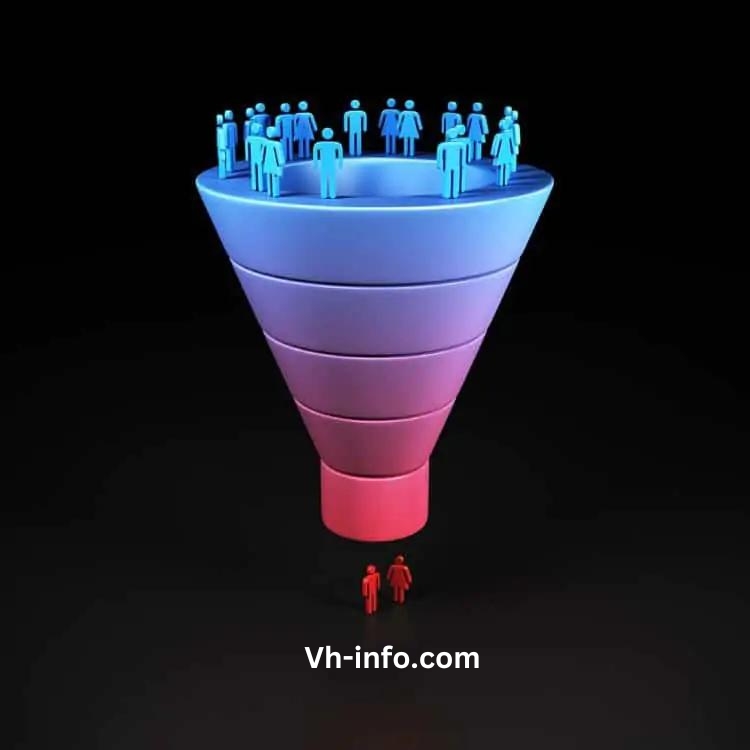
If you take a closer look at how customers go through the process, you’ll see that the funnel has more parts than Elias St. Elmo Lewis initially talked about.
In this version, they’ve added ‘loyalty‘ and ‘advocacy‘ stages because businesses now understand how important it is to have customers who stick around and speak highly of them.
A good experience after someone becomes a customer doesn’t just mean they buy again; it often leads to them saying great things about the business.
Considering that lots of people (about 92% of B2B buyers) are more likely to buy if they read a positive review, these added stages help bring in more potential customers at the top of the funnel.
That’s why many businesses are connecting an inverse funnel to the bottom of the regular one.
The Hourglass
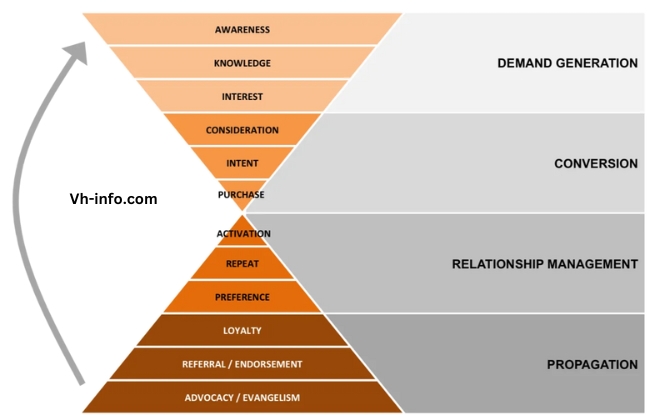
When you mix the usual funnel with this flipped-over ‘customer experience‘ funnel, it’s called the ‘hourglass.’
After the sales and marketing part ends, the customer support part starts, giving your customers an all-around experience.
After making a sale, the next step is turning your customers into fans, and these happy customers can bring in even more customers.
How to Utilize the Marketing Funnel for your Business?

Think of the marketing funnel like a musical orchestra where every musician has to play their role right. The funnel’s success relies on each stage leading to the next.
If they don’t work well together, the ultimate goal of turning potential customers into actual customers and then into advocates is hard to achieve.
Here’s what you need to know to guide your customer through each stage:
The Awareness Stage
This is when your potential customer first realizes they have a problem and begins searching for a solution. Their aim is to name their problem and explore possible fixes.
For instance, if they’re puzzled by taxes, they might be thinking about hiring a CPA or using tax software. Your goal is to position yourself as a good solution with a clear unique selling point (USP) and show your expertise through educational content.
This starts by getting people to visit your website and turning them into email subscribers.
The best content to offer includes blog posts, website content, webinars, guides, social media posts, and email newsletters.
Keep an eye on metrics like website traffic, social reach, email subscribers, inbound links, and referrals.
The Consideration Stage
Understanding User Intent: Top of Funnel vs Bottom of Funnel
The marketing funnel has different stages, and the first stage changes depending on the model used. Some models call it ‘interest‘ and ‘desire,’ while others use ‘like‘ and ‘trust.’ The reason for these differences is where it fits in the funnel.
The consideration stage is more significant than the others since it takes weeks or months for potential customers to decide if a business can solve their problem. During this time, it’s essential to guide them with helpful content.
Customers look for products or services that can solve their problem and start checking out businesses in that category.
You need to nurture leads with emails, blog posts, and lead magnets to show that your business is an expert at solving their problem. This stage is where the marketing team hands off leads to the sales team, so define a sales-qualified lead (SQL) clearly.
Offer ebooks, case studies, free tools, whitepapers, and webinars as your best content. Keep an eye on metrics like email open rates, landing page conversion rates, lead source, cost per lead, and lead quality.
The Purchase Stage
At this stage, leads choose a product or service to solve their problem. It follows the collaborative efforts of the sales and marketing teams to educate and nurture the lead.
In traditional marketing models, this stage marked the end of the funnel. However, for modern businesses, the “action” or “purchase” stage is just the beginning. It can lead to exponential growth by progressing into the “loyalty” and “advocacy” stages.
The lead’s goal is to select a business and specific solution that can address their problem. For instance, if someone is seeking DIY tax software, this is when they decide on both the brand and the specific version (e.g., basic or deluxe).
Your objective here is to demonstrate how your offering can solve their particular problem and assist them in choosing the best product. While the consideration stage establishes your authority and capability, this stage focuses on providing detailed solutions. If your product is software, offering free trials and demos allows leads to try before they make a purchase.
For service-based businesses, a one-on-one consultation can show you can solve a unique problem. If you have a physical product, detailed testimonials and case studies can persuade leads to click “buy.”
The best content includes testimonials, detailed case studies, product comparisons, whitepapers, demos, free trials, and consultations. Keep an eye on metrics like customers, lead-to-sale conversion rate, revenue, and the cost of customer acquisition.
The Loyalty Stage
At the start of a customer relationship, it’s like a honeymoon. They’re excited to have their problem solved, but they need ongoing support. If you don’t give them help, they might leave for another business. This step in the marketing funnel varies across businesses. Providing education and support in your sales funnel as a part of your customer journey can make customers loyal and more valuable to you. This approach is particularly effective in an eCommerce sales funnel, where well-timed information and assistance can guide customers smoothly from product discovery to purchase.
Understanding user intent is key when it comes to the top and bottom of funnel. You want your customer to experience your product’s value and learn new ways to use it during this stage. It’s also a time for them to decide if they’re satisfied enough to try any other products you offer.
Your job is to provide continuous support, such as FAQs, tutorials, blog posts, chat, and social media content. Metrics like recurring revenue, customer lifetime value, active customers, and churn rate should be monitored for success for customer’s journey. If this stage is too short, it may impact their decision-making process and loyalty.
The Advocacy Stage
Understanding the user intent is crucial for marketing funnel success. The ‘advocacy‘ stage rewards your effort by making your funnel bigger and it’s less time-consuming.
Happy customers stay loyal and recommend you to others with similar problems. They talk about your great product and service, giving you an edge over competitors.
With a friend’s recommendation, your business becomes top of mind when they start looking for a solution. In the ‘advocacy‘ stage, your customers become like spokespeople for your brand. They guide their friends from the “awareness” stage straight to “consideration” in your funnel.
Your goal is to make your funnel grow by turning your customers into advocates.
For your customer, the goal is to help their friends overcome problems like they did.
The best content includes surveys, referral incentives, and loyalty discounts. Keep an eye on metrics like Net Promoter Score, referrals, and reviews.
What Is Upper-Funnel Marketing?
Upper funnel marketing, also known as top of the marketing funnel, focuses on building awareness, interest, and desire among potential customers, including new visitors.
It’s like introducing your brand to people who just realized they have a problem and need a solution but don’t know about your brand yet. The goal here is to teach them about your brand and show that you’re the best solution for their needs.
In simpler terms, it’s about making people aware of your brand and capturing their interest when they are in the early stages of discovering solutions to their problems.
Importance of Top-of-Funnel Marketing
Top-of-funnel marketing, including marketing tactics like content marketing and social media, is super important because it lets you reach a lot of different people and make the middle and lower parts of your digital marketing plan work better.
When you connect with buyers just starting their journey, it’s like building your brand and making your reputation strong.
Using strategies like content marketing and social media in the top-of-funnel stage helps you connect with potential customers, and sometimes, you might even turn them into customers without moving them further down the digital marketing process.
Strategies for Top-of-Funnel Marketing
In the top-of-funnel marketing stage, the main goal is to get people interested in your brand and learn more about it.
To do this, you can use strategies like:
- Search Engine Optimization (SEO): This helps people find you when they search online.
- Pay-Per-Click (PPC) Ads: These are online ads that you pay for when people click on them.
- Paid Social Media Posts: Ads on social media platforms that you pay for to reach a larger audience.
- Content Marketing: This includes creating blogs and videos that provide useful information.
- Connected TV Advertising: Ads that appear on streaming services.
When making ads for these strategies, use language that encourages people to take action.
For example, in a social media marketing campaign, you might offer a webinar or special content to those who sign up for your newsletter. The social media posts would highlight the benefits of the webinar to encourage sign-ups for your social media ads.
If people sign up, they can learn more about your brand through newsletters or by following you on social media. It’s all about making people curious and interested in what you have to offer.
What Is Lower-Funnel Marketing?
Lower-funnel marketing, also known as bottom-of-the-funnel marketing, is all about talking to potential customers who know they have a problem, are familiar with your brand, and are figuring out whether to buy from you or someone else.
If you’ve done a good job with top-of-funnel marketing, you’ve got more leads here who are almost ready to make a decision. In lower funnel marketing, you’re trying to get those customers to buy.
At this stage, your main goal is to close the deal. You’re addressing their questions, overcoming objections, and showing why they should pick you over the competition. It’s the final step before turning a potential customer into a happy customer.
Importance of Bottom-of-Funnel Marketing
Bottom-of-funnel marketing, also known as the conversion funnel, is the part where you aim to seal the deal with a potential customer.
By this stage, the prospect already knows about your company and is thinking about making a purchase. They just need that little push to go from “add to cart” to “check out.”
This stage, known as the action stage, is crucial because it’s where prospects become customers. Doing well with your marketing strategy here not only helps you make sales but also builds customer loyalty.
It’s a way to turn people you’ve guided through the process into customers who come back and generate more revenue for your business. Share social proof, like customer reviews and testimonies, to build even more trust.
Strategies for Bottom-of-Funnel Marketing
During the bottom-of-funnel marketing stage, your messages should be short and prompt action.
Instead of talking broadly about how your brand helps customers, focus on why someone should choose you over others.
Strategies here involve standing out and proving you’re the best.
This can include:
- Case Studies: Real examples of how your product or service helped others.
- Product Comparisons: Showcasing why your offering is better.
- Promo Codes and Special Discounts: Incentives to encourage a purchase.
- Product Demonstrations: Showing how your product works.
- Client Testimonials: Positive reviews from satisfied customers.
Ads and campaigns at this stage should be convincing. Instead of giving an overview of your company, a good campaign will zoom in on your product or service, answering customer questions and guiding them to make a purchase.
Like in the top-of-funnel stage, you can use content and video marketing, but now it should specifically highlight what makes your product unique and why a potential customer should choose yours. It’s all about making a compelling case for your brand.
Top of Funnel vs Bottom of Funnel
| Top of Funnel (TOFU) | Bottom of Funnel (BOFU) | |
|---|---|---|
| Goal | Awareness and education | Lead nurturing and conversion |
| Audience | Broad, new prospects | Qualified leads closer to purchasing |
| Tactics | Content marketing, social media, SEO, advertising | Email marketing, sales calls, demos, discounts |
| Metrics | Impressions, reach, clicks | Leads, demos, trials, sales |
| Content Focus | Educates and attracts | Persuades and converts |
| Activities | Casts a wide net | Reels leads in |
| Buyer’s Journey | Early stages | Later stages nearing purchase |
How does the Marketing Funnel differ for B2C and B2B Brands?
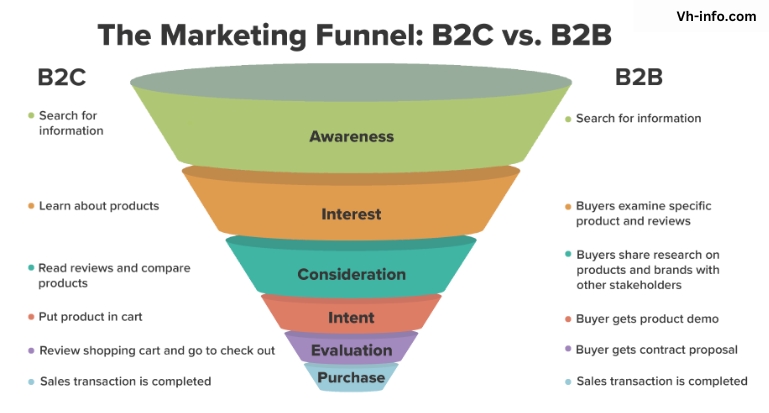
The marketing funnel is a bit different for B2C (business-to-consumer) and B2B (business-to-business) brands.
For B2C, people usually go through the funnel on their own or with advice from friends and family. In B2B, there’s often a bigger buying group involving different departments, around 5.4 people on average.
Also, B2C customers might not directly talk to a company representative, especially online. But in B2B, customers usually interact with a sales rep, especially towards the end of the funnel.
So, B2C is more individual-focused, while B2B involves a group decision with more interactions.
Examples of Marketing Funnels
Netflix

Netflix has changed how TV works. They use social media and sneaky marketing to make people aware of their new shows. On platforms like TikTok and Instagram, they give a sneak peek of the shows with interesting summaries and short clips. They also share behind-the-scenes stuff and interviews with the characters, keeping fans excited.
Crazy Egg

This famous tool helps businesses understand what people do on their websites. When it started, the company gave talks and offered $99 memberships to popular blogs for reviews.
But what really brought people to their site was the awesome content—informative, helpful, and relevant. They shared it on social media, emails, and through influencers, guiding people to think about using their tool.
Once you subscribe, you find a simple website with convincing words, a great user experience, and proof that others like it, all making you more likely to become a customer.
Basecamp
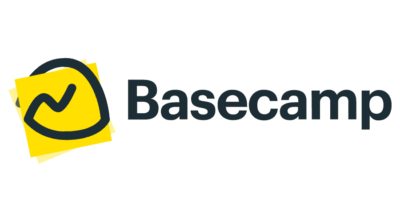
Basecamp is a tool for teams to work together and manage projects. They make customers happy, and those happy customers talk about Basecamp to others, giving it free advertising. They also have a podcast called “Rework” where the founder and friends share their views on work and business.
On the Basecamp website, they quickly explain what they do and how it helps, guiding potential customers through the process. Their invitation to try is appealing with a clear “no credit card necessary” tagline, making it easy for people to join.
After that, they show off good reviews in a big, attention-grabbing way.
If you click to join, you’ll find a simple and quick form, making it easy for you. Once you sign up, the CEO sends a welcome message with a brief guide on how to use the platform.
Driving Leads Through the Marketing Funnel with Top and Bottom Strategies
When designing your marketing strategy, it’s important to utilize both top of funnel and bottom of funnel tactics to attract and convert leads.
The top of the funnel focuses on positioning your brand, generating awareness, and acquiring net new leads through content marketing, paid advertising, and segmented messaging.
As leads progress down the funnel and show increased intent, bottom of funnel strategies like specialized offers, focused value propositions, and direct customer research convert them into delighted customers.
By balancing broad, awareness-building techniques at the top with targeted, conversion-focused tactics on the bottom, brands can optimize their entire funnel for revenue growth.
Conclusion
To use the marketing funnel well, know its stages and adjust strategies accordingly.
The top of the funnel (ToFu) makes people aware of your brand and brings in many viewers. Spread the word about your company to potential customers.
At the bottom of the funnel (BoFu), turn leads into buyers and maximize sales. Use various methods at each stage, like social media ads or personalized offers.
Knowing what users want is vital for good marketing.
Whether you’re targeting other businesses or regular people, help them through their buying process and offer value they’ll appreciate. Using strategies from both ends of the funnel creates brand awareness, gets leads, and turns them into loyal buyers.
Understand different stages of the marketing funnel to create a successful plan for your company. Map out your strategy, try new things, and see growth!

